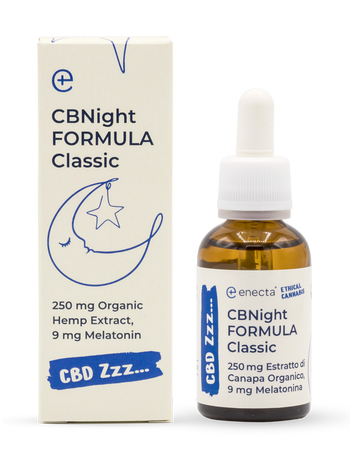Cannabinol (CBN) is a much less known cannabinoid compared to the renowned CBD (cannabidiol) and THC (delta-9-tetrahydrocannabinol) but is eliciting increasing interest, due to its potential applications in the field of human health.
An almost unknown active principle, Cannabinol (CBN) proposes new horizons in research
THC and CBD are already present in the form of acids in the first stages of growth and ripening of the cannabis plant.
CBN and cannabis: where can cannabinol be found?
Cannabinol (CBN) develops subsequently when THC is exposed to oxygen and heat. The resulting oxidation converts THC in CBN.
This is the reason why the presence of huge quantities of CBN is generally associated with very aged cannabis inflorescences.
CBN, however, does not provoke alterations and hasn't got narcotic effects.
CBN hasn't got any psychoactive effects and isn't present on the list of “narcotic” drugs.
What role has CBN got in our organism
Cannabinol (CBN) binds to the CB2 receptors (and partially to the CB1 receptors) of our endocannabinoid system. According to the - few – scientific studies which are investigating its properties, CBN, has a strong sedative action, but without resulting in the narcotic effects of THC.
This marked characteristic is increasingly gaining interest in the medical research sector.
The very first studies are supplying the first, interesting, conclusions which could open a new research front for the exploration of the role of this specific cannabinoid as well.
A study published in August 2019 by researchers of the University of British Columbia, in Canada, has suggested that the peripheral application of CBN could supply significant relief to chronic muscle disorders like, for example, temporomandibular disorders (associated to the area which includes the jawbone and the base of the skull), without generating side effects.
Other studies suggest the potential effectiveness of CBN to improve sleep or to give relief in the case of psoriasis and inflammations or skin burns.
Furthermore, the first evidence emerged of the contribution cannabinol (CBN) would be able to give in the development of bone tissue, particularly important after specific traumas. Without a doubt, were the results obtained in the field of dermatology which generated the initial interest in Cannabinol.

Cannabis for skin care. The future of CBN?
Cannabis and, in particular, cannabidiol, are commonly used, today, for the preparation of skincare products, with an accent on health conditions like psoriasis.
It is in this specific field, in fact, in which cannabinol (CBN) could be applied most. Scientific research has been increasingly demonstrating which benefits the topical use of products containing cannabidiol (CBD), delta-9-tetrahydrocannabinol (THC) and other cannabinoids can have on patients affected with psoriasis.
Cannabinoids, in fact, act on the inflammatory state of the skin typical of this disorder. CBN actually seems to have the capability of regulating the production of skin cells and has shown to be effective in treating the symptoms caused by Staphylococcus aureus, a bacteria which has become methicillin-resistant and causes the infections often preceding the outbreak of psoriasis.
A review of studies published in 2016 has demonstrated how the active principles of cannabis can be utilized successfully in the treatment of various forms of psoriasis.
One of the most common manifestations of psoriasis is the excessively rapid reproduction of the skin cells. In 2007 researchers of the Medical School - University of Nottingham, observed how some active principles of the cannabis plant – THC, CBD, and CBN – were able to slow down the abnormal growth of keratinocytes, the most common cells of the epidermis.
Furthermore, studies have been carried out on the possible permanence of cannabinol (CBN) at the level of the epidermis and the dermis during a research aimed at supplying the parameters of possible false positives in tests detecting the presence of substances considered illegal.
It was demonstrated how no traces of cannabinoids were found after having washed the hair with a shampoo containing CBD, THC, and CBN.
We are talking about a handful of preliminary results only, which nonetheless have generated interest and have suggested a line of research aimed at the understanding of this specific active principle of the cannabis plant, which has been neglected too much, so far.

































